|
Departments
eBook now Available!
|
Exclusive - THE book on Traditional & Classic
Siamese cats
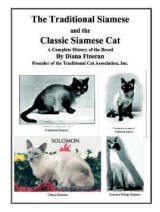
Written by the Founder of TCA, Inc.
Tullycrine
Affordable
Web Design
|
|
|
FAQ - THE TRADITIONAL
MANX and the TRADITIONAL LONGHAIR©® MANX (AKA: CYMRIC)
Copyright Diana Fineran August 4, 2004
HISTORY
The exact primary source of this tailless breed is shrouded
in legends as surely as its place of discovery, the Isle of Man, has its fog.
The mystery hasn’t found a satisfactory explanation. Persistent legends connect
shipwrecks with the Traditional Manx’s introduction to its island home. Many
ships docked there too, bringing with them their sailing cats. These cats could
have trotted down the gangplank to their new island home.
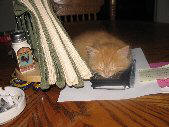 Historically the Traditional Manx is an old breed, having
been around for at least several hundred years. Both shorthaired (Manx) and
longhaired (aka. Cymric) versions of the breed were present from the beginning.
Some have suggested that the longhaired Cymric was the result of a Manx to
Persian out cross occurring in the 1930’s and 1940’s. Others insist the Cymric
was not a human bred hybrid. Unlike the Manx gene, however, long hair is a
recessive trait, meaning the gene could have been carried unnoticed through
generations of Manx. The longhaired version was called the Cymric, derived from
Cymru, the Welsh or Celtic word for Wales. It is correctly pronounced (KOOM-rick)
but ordinarily pronounced (KIM-rick). The Cymric name was chosen by Blair
Wright and Leslie Falteisek. They were two Cymric breeders involved in the
recognition of the breed. It was Wright’s grandmother who said she saw
longhaired, tailless cats in Wales, thus inspiring the breeds Celtic moniker. To
maximize support and improve the breeds visibility, TCA, INC. has combined the
two using one breed name, but with two divisions. Historically the Traditional Manx is an old breed, having
been around for at least several hundred years. Both shorthaired (Manx) and
longhaired (aka. Cymric) versions of the breed were present from the beginning.
Some have suggested that the longhaired Cymric was the result of a Manx to
Persian out cross occurring in the 1930’s and 1940’s. Others insist the Cymric
was not a human bred hybrid. Unlike the Manx gene, however, long hair is a
recessive trait, meaning the gene could have been carried unnoticed through
generations of Manx. The longhaired version was called the Cymric, derived from
Cymru, the Welsh or Celtic word for Wales. It is correctly pronounced (KOOM-rick)
but ordinarily pronounced (KIM-rick). The Cymric name was chosen by Blair
Wright and Leslie Falteisek. They were two Cymric breeders involved in the
recognition of the breed. It was Wright’s grandmother who said she saw
longhaired, tailless cats in Wales, thus inspiring the breeds Celtic moniker. To
maximize support and improve the breeds visibility, TCA, INC. has combined the
two using one breed name, but with two divisions.
The Isle of Man is located in the Irish Sea half way
between Liverpool, England and Belfast, Ireland. It is a tiny island with only
221 square miles – 32 miles long and 13 miles wide. Its inhabitation began in
Neolithic times. I found conflicting stories concerning whether there were cats
already on the island of British Shorthair variety before the tailless Manx
arrived. One stated the island didn’t have an indigenous cat species of its
own, so the Traditional Manx was it’s first. Another mentioned the Manx was a
spontaneous mutation among the island’s domestic cats, rather than a cat that
arrived with its tail already absent. No one really knows for sure.
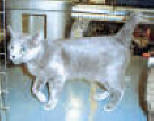 There
are early reports about the Spanish Armada carrying them to the Isle of Man
through two ships wrecked off Spanish Point, near Port Erin in 1558. The breed
was to have been propagated by cats who escaped from those ships. An old Manx
newspaper mentioned, “In 1808 an East County ship was wrecked on Jurby Point,
and a rumpy cat swam ashore.” In 1902 Mr. Gambier Bolton wrote in Frances
Simpson’s, “Book of the Cat”, “In the Isle of Man today we find a rock named the
Spanish Rock, which stands close into the shore, and Tradition states that here
one of the vessels of the Spanish Armada went down in the memorable year 1558,
and that among the rescued were some tailless cats which had been procured
during one of the vessel’s voyages to the Far East. The cats first swam to the
rock, and then made their way to shore at low tide, and from these have sprung
all the so called Manx cats which are now to be found in many parts of Great
Britain, Europe and America.” There
are early reports about the Spanish Armada carrying them to the Isle of Man
through two ships wrecked off Spanish Point, near Port Erin in 1558. The breed
was to have been propagated by cats who escaped from those ships. An old Manx
newspaper mentioned, “In 1808 an East County ship was wrecked on Jurby Point,
and a rumpy cat swam ashore.” In 1902 Mr. Gambier Bolton wrote in Frances
Simpson’s, “Book of the Cat”, “In the Isle of Man today we find a rock named the
Spanish Rock, which stands close into the shore, and Tradition states that here
one of the vessels of the Spanish Armada went down in the memorable year 1558,
and that among the rescued were some tailless cats which had been procured
during one of the vessel’s voyages to the Far East. The cats first swam to the
rock, and then made their way to shore at low tide, and from these have sprung
all the so called Manx cats which are now to be found in many parts of Great
Britain, Europe and America.”
Rev. W.B. Clarke stated, “A Baltic ship wrecked between
Castle Rushen and the Calf was responsible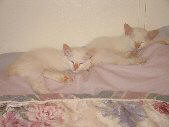 for the introduction of the
Traditional Manx cat to the island. As the vessel drew close to the shore two
or three tail less cats leaped from the bowsprit and were taken by the wreckers.
These were the first of the kind ever seen in Man.” for the introduction of the
Traditional Manx cat to the island. As the vessel drew close to the shore two
or three tail less cats leaped from the bowsprit and were taken by the wreckers.
These were the first of the kind ever seen in Man.”
The naturalist, Kaempfer, postulated in 1902, “Definitely
the specimens of this breed now so common in parts of Russia all came originally
from Japan.”
Other legends say these cats were brought onto the Isle
from Japan by Phoenicia traders, or they came with the Vikings who colonized the
Isle. Even more fanciful yarns account for the Traditional Manx’s lost tail.
One postulates that two cats were going onto Noah’s ark but they dawdled, so the
door was slammed on their tails. Another fable claims they are a cross between
a cat and a rabbit. Another maintains the Vikings used cat’s tails as helmet
plums so the mother cats nipped off the tails of their kittens to protect them
from thieves. All of these can tickle the imagination, but are rooted in
mystery!
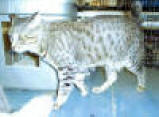 A version of the Noah story was put to verse by an unknown
writer, A version of the Noah story was put to verse by an unknown
writer,
“Noah, sailing o’er the seas,
Ran high and dry on Ararat,
His dog then made a spring, and rook
The tail from off a pussy cat.
Puss through the window quick did fly,
And bravely through the waters swam,
Nor ever stopped, till, high and dry,
She landed on the Isle of Man.
Thus tailless puss earned Mona’s thanks.
And ever after was called Manx.”
In any case it is reasonable to say the origin of the
Traditional Manx to the Isle of Man was from a foreign source and they developed
as a natural, spontaneous mutation.
An explorer of the time, Auguste Pavie, thought the
Annamite cats could have been connected in
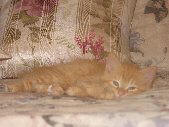 some way to the Traditional Manx.
These small cats he said “ had a graceful shape, yellow eyes and naturally
short tails.” During an invasion they were brought to Burma, and could have
traveled to the East Indies from Britain by English trading expeditions in the
18th century. some way to the Traditional Manx.
These small cats he said “ had a graceful shape, yellow eyes and naturally
short tails.” During an invasion they were brought to Burma, and could have
traveled to the East Indies from Britain by English trading expeditions in the
18th century.
Siam and Malaya also were considered sources of the
Traditional Manx, because cats with malformed tails such as kinked, knotted, or
clubbed were in abundance there. This condition has endured there for many
decades. In addition to the Cat Book Poems, mention was made as far back as
1783 by William Marsden, F.R.S., then Secretary to the President and Council of
Sumatra. In his “History of Sumatra”, he wrote, “All their tails imperfect and
knobbed at the end.”
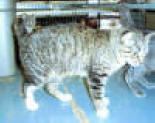 The
Traditional Manx breed was popular and well established long before the advent
of cat associations. They were exported from the Isle of Man. King Edward VIII
was supposedly a Traditional Manx fancier and often attended cat shows featuring
the breed. The first “Manx club” was formed in England in 1901. In the 1930’s
they were imported to the US. As demand grew the supply on the Isle of Man
waned. They became rare. Since they have been known for centuries with the
same characteristics, they could be said to be the least changed of all of the
cat breeds. The
Traditional Manx breed was popular and well established long before the advent
of cat associations. They were exported from the Isle of Man. King Edward VIII
was supposedly a Traditional Manx fancier and often attended cat shows featuring
the breed. The first “Manx club” was formed in England in 1901. In the 1930’s
they were imported to the US. As demand grew the supply on the Isle of Man
waned. They became rare. Since they have been known for centuries with the
same characteristics, they could be said to be the least changed of all of the
cat breeds.
The Traditional Manx’s tail abbreviation is governed by a
dominant gene, along with modifying polygenes. It has been proven that the
Traditional Manx has no relationship to the Japanese Bobtail, who’s short tail
is governed by a recessive rather than a dominant gene. This rules out any
connection between the two breeds.
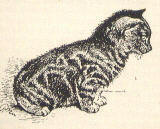 From
“Our Cats and All About Them” by Harrison Weir, F.R.H.S., 1889, “The Manx cat is
well k known, and is by no means uncommon. It differs chiefly from the ordinary
domestic cat in being tailless, or nearly so, the best breeds not having any;
the hind legs are thicker and rather longer, particularly in the thighs. It runs
more like a hare than a cat the action of the legs being awkward, nor does it
seem to turn itself so readily, or with such rapidity and ease; the head is
somewhat small for its size, yet thick and well set on a rather long neck; the
eyes large, round, and full, ears medium, and rather rounded at the apex. In
colour they vary, but I do not remember to have seen a white or many black,
though one of the best that has come under my notice was the latter colour. I
have examined a number of specimens sent for exhibition at the Crystal palace
and other cat shows, and found in some a very short, thin, twisted tail, in
others a mere excrescence, and some with an appendage more like a knob. These I
have taken as having been operated upon when young, the tail being removed, but
this may not be the case, as Mr. St. George Mivart in his very valuable book on
the cat, mentions a case where a female cat has her tail so injured by the
passage of a cart wheel over it, that her master judged it best to have it cut
off near the base. Since then she has had two litters of kittens, and in each
litter one or more of the kittens had a stump of tail, while their brothers and
sisters had tails of the usual length. But were there no Manx cats in the neighbourhood, is a query. St. George Mivart further states that Mr. Bartlett
told him, as he has so stated to myself, that in the Isle of Man the cats have
tails of different lengths, from nothing up to ten inches. I cannot, myself,
come to the same conclusion as to the origin of the Manx cat. Be this as it
may, one thing is certain; that cross breed Manx with other cats often have
young that are tailless. As a proof of this, Mr. Herbert Young, of Harrogate,
has had in his possession a very find red female long-haired tailless cat, that
was bred between the Manx and a Persian. Another case showing the strong
prepotency of the Manx cat. Mr. Hodgkin, of Eridge, some time ago had a female
Manx cat sent to him. From
“Our Cats and All About Them” by Harrison Weir, F.R.H.S., 1889, “The Manx cat is
well k known, and is by no means uncommon. It differs chiefly from the ordinary
domestic cat in being tailless, or nearly so, the best breeds not having any;
the hind legs are thicker and rather longer, particularly in the thighs. It runs
more like a hare than a cat the action of the legs being awkward, nor does it
seem to turn itself so readily, or with such rapidity and ease; the head is
somewhat small for its size, yet thick and well set on a rather long neck; the
eyes large, round, and full, ears medium, and rather rounded at the apex. In
colour they vary, but I do not remember to have seen a white or many black,
though one of the best that has come under my notice was the latter colour. I
have examined a number of specimens sent for exhibition at the Crystal palace
and other cat shows, and found in some a very short, thin, twisted tail, in
others a mere excrescence, and some with an appendage more like a knob. These I
have taken as having been operated upon when young, the tail being removed, but
this may not be the case, as Mr. St. George Mivart in his very valuable book on
the cat, mentions a case where a female cat has her tail so injured by the
passage of a cart wheel over it, that her master judged it best to have it cut
off near the base. Since then she has had two litters of kittens, and in each
litter one or more of the kittens had a stump of tail, while their brothers and
sisters had tails of the usual length. But were there no Manx cats in the neighbourhood, is a query. St. George Mivart further states that Mr. Bartlett
told him, as he has so stated to myself, that in the Isle of Man the cats have
tails of different lengths, from nothing up to ten inches. I cannot, myself,
come to the same conclusion as to the origin of the Manx cat. Be this as it
may, one thing is certain; that cross breed Manx with other cats often have
young that are tailless. As a proof of this, Mr. Herbert Young, of Harrogate,
has had in his possession a very find red female long-haired tailless cat, that
was bred between the Manx and a Persian. Another case showing the strong
prepotency of the Manx cat. Mr. Hodgkin, of Eridge, some time ago had a female
Manx cat sent to him.
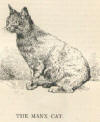 Not
only does she produce tailless cats when crossed with the ordinary cat, but the
progeny again crossed also frequently have some tailless kittens in each
litter. I have also been told there is a breed of tailless cats in Cornwall.
Mr. Darwin states in his book on, “The Variation of Animals and Plants under
Domestication,” Vol. I. P. 47, that “throughout an immense area, namely, the
Malayan Archipelago, Siam, Pequan, and Burmah, all the cats have truncated tails
about half the proper length, often with a sort of knob at the end. In a note
Mr. Darwin says, “The Madagascar cat is said to have a twisted tail.” (See
Desmares, in Encyclop. Nat. Mamm., 1820, P. 233 for some other breeds.) Mr.
St. George Mivart also corroborates the statement, so far as the Malay cat is
concerned. He says the tail is only half the ordinary length, and often
contorted into a sort of knot, so that it cannot be straightened. He further
state, “It’s contortion is due to deformity of the bones of the tail,” and there
is a tailless breed of cats in the Crimea. Some of the Manx cats I have
examined have precisely the kind of tail here described-thin, very short, and
twisted, that cannot be straightened. Is it possible the
Manx cat
originated with the Malayan? Or rather is it a freak of nature perpetuated by
selection? Be this as it may, we have the Manx cat now as a distinct breed,
and, when crossed with other, will almost always produce some entirely tailless
kittens, if not all.” Not
only does she produce tailless cats when crossed with the ordinary cat, but the
progeny again crossed also frequently have some tailless kittens in each
litter. I have also been told there is a breed of tailless cats in Cornwall.
Mr. Darwin states in his book on, “The Variation of Animals and Plants under
Domestication,” Vol. I. P. 47, that “throughout an immense area, namely, the
Malayan Archipelago, Siam, Pequan, and Burmah, all the cats have truncated tails
about half the proper length, often with a sort of knob at the end. In a note
Mr. Darwin says, “The Madagascar cat is said to have a twisted tail.” (See
Desmares, in Encyclop. Nat. Mamm., 1820, P. 233 for some other breeds.) Mr.
St. George Mivart also corroborates the statement, so far as the Malay cat is
concerned. He says the tail is only half the ordinary length, and often
contorted into a sort of knot, so that it cannot be straightened. He further
state, “It’s contortion is due to deformity of the bones of the tail,” and there
is a tailless breed of cats in the Crimea. Some of the Manx cats I have
examined have precisely the kind of tail here described-thin, very short, and
twisted, that cannot be straightened. Is it possible the
Manx cat
originated with the Malayan? Or rather is it a freak of nature perpetuated by
selection? Be this as it may, we have the Manx cat now as a distinct breed,
and, when crossed with other, will almost always produce some entirely tailless
kittens, if not all.”
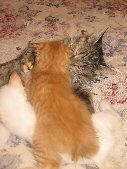 “The illustration I give is that of a prize winner at the
Crystal palace in 1880, “The illustration I give is that of a prize winner at the
Crystal palace in 1880,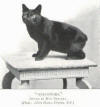 1881, 1882, and is the property of Mr. J.M. Thomas, of Parliament Street. In
colour it is a brindled tortoiseshell. It is eight years old. At the end of
this description I also give a portrait of one of its kittens, a tabby; both are
true Manx, and neither have a particle of tail, only a very small tuft of hair
which is boneless. The hind quarters are very square and deep, as contracted
with other cats, and the flank deeper, giving an appearance of great strength,
the hind legs being longer, and thicker in proportion to the fore legs, which
are much slighter and tapering; even the toes are smaller. The head is round
for a she-cat, and the ears some what large and pointed, but thin and fine in
the hair, the cavity of the ear has less hair within it, than some other
short-haired cats, the neck is long and thin, as are the shoulders. It’s
habitats
are the same as those of most cats. I may add that Mr. Thomas, who is an old
friend of mine, has had this breed many years, and kept if perfectly pure.”
1881, 1882, and is the property of Mr. J.M. Thomas, of Parliament Street. In
colour it is a brindled tortoiseshell. It is eight years old. At the end of
this description I also give a portrait of one of its kittens, a tabby; both are
true Manx, and neither have a particle of tail, only a very small tuft of hair
which is boneless. The hind quarters are very square and deep, as contracted
with other cats, and the flank deeper, giving an appearance of great strength,
the hind legs being longer, and thicker in proportion to the fore legs, which
are much slighter and tapering; even the toes are smaller. The head is round
for a she-cat, and the ears some what large and pointed, but thin and fine in
the hair, the cavity of the ear has less hair within it, than some other
short-haired cats, the neck is long and thin, as are the shoulders. It’s
habitats
are the same as those of most cats. I may add that Mr. Thomas, who is an old
friend of mine, has had this breed many years, and kept if perfectly pure.”
From “The Book of the Cat” by Frances Simpson, 1902,
 “These
quaint cats are rapidly and surely coming into notice in the fancy. As a breed
they are intelligent and affectionate, and, I believe, splendid sporting cats.
They are undoubtedly great favourites amongst the sterner sex, perhaps because
they are such keen and plucky ratters. As a breeder of Persian cats
(Traditional Persian, Doll Face), and having become used to the beautiful
wide-spreading tails of these cats, I confess there is something grotesque and
unfinished, to my eyes, in the Manx, and from choice I should not care to keep
these tailless pussies as pets. They do not appeal to me and to my sense of the
beautiful. Having, therefore, never kept or bred Manx cats, I feel diffident in
writing about them; but I have carefully studied those exhibited, and have also
had opportunities of judging of their points whilst visiting friends who have
fallen victims to the fascinations of these curious felines. I know a good Manx
when I see one, and to prove this assertion I will tell an incident in
connection with a prize-winning Manx of today. A friend of mine living in
London took compassion on a little stray black kitten who came crying for food.
She fed him, and repeatedly tried to find poor pussy’s owner, but in vain. I
was appealed to know what had “These
quaint cats are rapidly and surely coming into notice in the fancy. As a breed
they are intelligent and affectionate, and, I believe, splendid sporting cats.
They are undoubtedly great favourites amongst the sterner sex, perhaps because
they are such keen and plucky ratters. As a breeder of Persian cats
(Traditional Persian, Doll Face), and having become used to the beautiful
wide-spreading tails of these cats, I confess there is something grotesque and
unfinished, to my eyes, in the Manx, and from choice I should not care to keep
these tailless pussies as pets. They do not appeal to me and to my sense of the
beautiful. Having, therefore, never kept or bred Manx cats, I feel diffident in
writing about them; but I have carefully studied those exhibited, and have also
had opportunities of judging of their points whilst visiting friends who have
fallen victims to the fascinations of these curious felines. I know a good Manx
when I see one, and to prove this assertion I will tell an incident in
connection with a prize-winning Manx of today. A friend of mine living in
London took compassion on a little stray black kitten who came crying for food.
She fed him, and repeatedly tried to find poor pussy’s owner, but in vain. I
was appealed to know what had
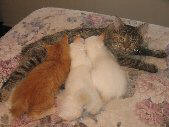 better be done, and when I was the little black
fellow I strongly recommended my friend to keep it and exhibit it at the next
large show, as I considered he would go in and win easily. She followed my
advice in the latter respect, but placed too low a figure on “Nig”, as she
declared she did not wish to go in for Manx. I warned her he would be sold, and
sure enough that clever and astute judge of cats of uncommon breeds, Mr. H.C.
Brooke, snapped him up at catalogue price; and since then he has blossomed forth
into a champion, and as “King Clinkie” has taken highest honours whenever
shown. It is only just to state that Mrs. Brooke most generously handed over
some of her winnings to “King Clinkies” former owner. better be done, and when I was the little black
fellow I strongly recommended my friend to keep it and exhibit it at the next
large show, as I considered he would go in and win easily. She followed my
advice in the latter respect, but placed too low a figure on “Nig”, as she
declared she did not wish to go in for Manx. I warned her he would be sold, and
sure enough that clever and astute judge of cats of uncommon breeds, Mr. H.C.
Brooke, snapped him up at catalogue price; and since then he has blossomed forth
into a champion, and as “King Clinkie” has taken highest honours whenever
shown. It is only just to state that Mrs. Brooke most generously handed over
some of her winnings to “King Clinkies” former owner.
The following photos were courtesy of Gale Thomas-Goodman
of Varary Mews Manx located at
www.manx--cats.com Please click on the pictures to enlarge.
|
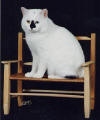
Vagary Hobgoblin |

GP Vagary Kiss Me Kate |
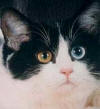
Vagary Kerrigan |

GC Vagary Lickety Split |
“I will therefore proceed to give my opinion of Manx cats,
but with all due deference to my fellow fanciers who have had personal
experience with the breed. I think I have judged every species of cat, long and
short haired, except Manx. I remember in former times stump-tails cats, called
Manx, used to win comfortably at shows, but in our up-to-date times I should
make a black mark in my judging book against those cats with a stump or an
appendage, or even a mere excrescence. I do not fear contradiction when I state
that a Manx cat of the true type should have no particle of tail – only a tuft
of hair, which ought to be boneless.”
“There are at present six distinct types of Manx, or
‘rumpy’ cats being exhibited at our shows (1902). The long straight backed cat,
the long roach backed cat, the long straight backed cat with high hind
quarters, the short straight backed cat, the short roach backed cat, the short
backed cat with high hind quarters. The last type is the correct one, the first
is the worst and commonest type, the others are intermediate and should be
judged accordingly.”
“The Manx cats should always be judged in a good, large,
empty pen, and never in their own pens, or when held by the judge.”
“At one time, we may presume, the Manx cat was kept pure in
the Isle of Man, but, alas! The natives, with an eye to the main chance, have
been led into manufacturing a spurious article, and many more tailless cats and
kittens than ever were born have been sold to tourists eager to carry home some
souvenir of the island to their friends on the mainland, I have been told that
the landing pier is a frequent resort of dealers in so called Manx cats, where
the unwary traveler is waylaid and sold! On some out of the way farms on the
island I believe none but tailless cats have been kept for generations, and some
genuine specimens may thus be picked up, if the tourist gives himself the
trouble to go off the beaten tracks.”
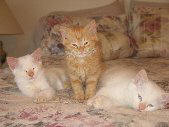 “The following letters which appeared in Our Cats, in the
issue of June 30th, 1900, will be read with interest. They were
written by two gentlemen of prominent position in the Isle of Man, but as they
did not wish to be identified as authorities on cats their names were not
given…” “The following letters which appeared in Our Cats, in the
issue of June 30th, 1900, will be read with interest. They were
written by two gentlemen of prominent position in the Isle of Man, but as they
did not wish to be identified as authorities on cats their names were not
given…”
“Letter 1, Castletown, Isle of Man, 12th July,
1898. “I received yesterday your letter respecting Manx cats. I fear I am
unable to aid you much in your inquiries as to the Manx cat, for any personal
information I can give.”
“When I was a boy there was a kind of tradition that the
tailless cat was brought here by the Spanish Armada. We have a headland called
‘Spanish Head,” where it was been believed that some tailless cats escaped and
took refuge here, and that from such cats all the so called Manx cats have been
derived. During my life I have frequently met persons who have traveled in
Spain, and I think I have always asked from such persons if they had ever met
with tailless cats there, but I never met anyone who had seen them. I never
heard any other origin of the Manx cat alleged. They are very common here, but
not so common as cats with tails. Both cats with and cats without tails
associate together. In my own house we have always kept cats, and in almost
every litter of kittens there are some with and some without tails. I have two
tailless cats now – one is a kitten of a few weeks old. It has no sign of a
tail ,but is (as designated here0 a pure rumpy. The mother is one also, but she
has a little fur tuft. I have frequently seen kittens having a very small
rudimentary tail, such as one or two bones.”
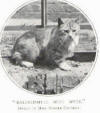
“I have seen, I think, Manx cats of most of the colours
mentioned by you, but the most common are the grey or tabby. I have never heard
of wild cats found here, and I do not think there is any tradition about them.”
“A few years ago I had a very fine tom cat (bred in my own
house), black all over, and with no sign of a tail. I lost it. I presume it
was stolen by some tripper. Trippers are frequently on the look out for Manx
cats, and I fear that many tailed kittens are deprived of their tails to meet
the demand.”
“Letter 2, Ramsey, 17th July, 1989. “Thank you
for letting me see the interesting letters about Manx cats. I suppose the
Society wants to have a standard by which to judge them.”
“I am sure we should all be interested to hear what they
have to say on the subject, and we may be able to add some general information.”
“To take the questions in order I should say that grey
tabby (barred, not spotted) is the most natural and correct, if one may so
speak. I think it is certainly most common. I have known tortoiseshell, black
and white, black, white and perhaps others, which I now forget. The eye, so far
as I know, is the same as in the common English tabby.”
“Certainly we have cats with tails. The rumpy being the
rare form. Perhaps one in a litter, and one or two of them with half tails.”
“As to what they are supposed to be, I have of course heard
the Spanish Armada story. My own belief is that they have originated in a
sport, e.g. as we find in dogs and fowls, and have been perpetuated as
curiosities, and in modern times on account of their commercial value.”
“I don not know that there is any type which can be said to
be more true than another with regard to size and shape of head, etc. The
height at the hind legs is perhaps more apparent than real, caused by the abrupt
ending, without the falling tail as in ordinary cats.”
“Professor Owen made a preparation, which may be seen at
the British Museum, showing the bones (if any) of the tail. I think in a
perfect specimen there should be no bones. Of course, there are all degrees of
stumps.”
Frances Simpson continued,
“It is only of recent years that any English fanciers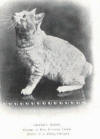 have tried to breed true Manx cats. Miss Samuel has been very successful in
establishing a strain which again and again breeds true to type. The
”Gold-Sticks” and “Kangaroo”, two noted winners, are owned by her. In former
days Miss Bugden’s “Gorrie”, Mr. Woodiwiss’s “Manx King,” “Pickles,” “Belle,”
and “Beauty,” all good cats, accounted for most of the prizes. Miss Jay, whose
name is more familiarly known in connection with Blue Persians, has always been
partial to Manx cats, and used to exhibit at the Crystal palace. The last time
I visited the Holmwood Cattery I was much struck with the number of
tortoiseshell Manx cats running about the stable yard. Miss Jay has quite a
family of these, but, needless to day, they are all of the female sex! Mrs.
Herring has not been unmindful of this breed, and has exhibited some good
specimens. Miss Dresser has owned Manx cats for many years and shown some good
ones, Her “Belle Mahone” and “Moonlight” were nice tabbies, free from tail, and
“Bonhaki Junior” was a very fine shaped silver tabby and white, but,
unfortunately he had a stump which always kept him back. Miss Mosely has
exhibited some good blacks. Lady Alexander owned several prize winning Manx, but
these have passed into the hands of Miss Hester Cochran. The best of these are
“Ballochmyle Bell Stump,” a curiously spotted tabby, absolutely tailless. “Bell
Spitz” and “Strathocona” are also good specimens in Miss Cochran’s possession.
Mr. Gambier Bolton owned and bred some fine cats. “Manx Primrose,” a black, and
“D-Tail,” a silver tabby, won respectively first and second at the Westminster
show in 1902. It is so unusual to see “Breeder and pedigree unknown” after
almost all the entries in the Manx classes that these two cats were
distinguished by having a certified pedigree. It was a grievous loss when
“D-Tail” disappeared very mysteriously from his home in St. John’s Wood. “Manx Silverwing” passed from Mr. Bolton’s possession to that of Mr. Foulstone’s, and
was later purchased by Mr. A. Ward, the well known cat specialist. As will be
seen from his photo, this puss is almost a spotted tabby.”
have tried to breed true Manx cats. Miss Samuel has been very successful in
establishing a strain which again and again breeds true to type. The
”Gold-Sticks” and “Kangaroo”, two noted winners, are owned by her. In former
days Miss Bugden’s “Gorrie”, Mr. Woodiwiss’s “Manx King,” “Pickles,” “Belle,”
and “Beauty,” all good cats, accounted for most of the prizes. Miss Jay, whose
name is more familiarly known in connection with Blue Persians, has always been
partial to Manx cats, and used to exhibit at the Crystal palace. The last time
I visited the Holmwood Cattery I was much struck with the number of
tortoiseshell Manx cats running about the stable yard. Miss Jay has quite a
family of these, but, needless to day, they are all of the female sex! Mrs.
Herring has not been unmindful of this breed, and has exhibited some good
specimens. Miss Dresser has owned Manx cats for many years and shown some good
ones, Her “Belle Mahone” and “Moonlight” were nice tabbies, free from tail, and
“Bonhaki Junior” was a very fine shaped silver tabby and white, but,
unfortunately he had a stump which always kept him back. Miss Mosely has
exhibited some good blacks. Lady Alexander owned several prize winning Manx, but
these have passed into the hands of Miss Hester Cochran. The best of these are
“Ballochmyle Bell Stump,” a curiously spotted tabby, absolutely tailless. “Bell
Spitz” and “Strathocona” are also good specimens in Miss Cochran’s possession.
Mr. Gambier Bolton owned and bred some fine cats. “Manx Primrose,” a black, and
“D-Tail,” a silver tabby, won respectively first and second at the Westminster
show in 1902. It is so unusual to see “Breeder and pedigree unknown” after
almost all the entries in the Manx classes that these two cats were
distinguished by having a certified pedigree. It was a grievous loss when
“D-Tail” disappeared very mysteriously from his home in St. John’s Wood. “Manx Silverwing” passed from Mr. Bolton’s possession to that of Mr. Foulstone’s, and
was later purchased by Mr. A. Ward, the well known cat specialist. As will be
seen from his photo, this puss is almost a spotted tabby.”
Lady Marcus
Beresford has lately shown a great partiality for Manx.  I think I am right in stating that the first one that inhabited the Bishopsgate
cattery was a beautiful white called “Mona,” that I procured fro her. This fine
specimen was brought from the island direct, and proved herself a splendid
ratter; but, alas! She did not live long to enjoy the luxuries of her new
home. There are however, no fewer than five Manx now at Bishopsgate – “Jack,” a
silver tabby, “Patch,” a tortoiseshell, “Satanella,” a black female, and
“Stumps,” a brown tabby male. The most recent addition is “King Clinkie,” whom
I have before mentioned as being owned by Mrs. H.K. Brooke. Does he ever think
of his former struggling existence, now that his ways are those of pleasantness
and peace? One of the latest of the specialist clubs is the Manx Club, formed
by Miss Hester Cochran in 1901, with an annual subscription of 10s. This has
been reduced to 5s., and the members in the beginning of 1903 numbered about
twenty. The club has, as far as possible, devoted its limited funds to
guaranteeing a better classification for Manx cats at the principal shows, and
when unable to afford a guarantee has given special prizes for competition. The
efforts of this small body of fanciers have been substantially rewarded by the
great improvement in the quantity and quality of the Manx cats exhibited during
the last eighteen moths. Miss H. Cochran, who has given up all other cats for
Manx, is the hon. Secretary, and Lady Alexander hon. Treasurer, Committee: Lady
Alexander, Miss H. Cochran, Mrs. Hering, and Miss White Atkins. No doubt in
time the officials and members of the Manx Club will be able to add to their
number.”
I think I am right in stating that the first one that inhabited the Bishopsgate
cattery was a beautiful white called “Mona,” that I procured fro her. This fine
specimen was brought from the island direct, and proved herself a splendid
ratter; but, alas! She did not live long to enjoy the luxuries of her new
home. There are however, no fewer than five Manx now at Bishopsgate – “Jack,” a
silver tabby, “Patch,” a tortoiseshell, “Satanella,” a black female, and
“Stumps,” a brown tabby male. The most recent addition is “King Clinkie,” whom
I have before mentioned as being owned by Mrs. H.K. Brooke. Does he ever think
of his former struggling existence, now that his ways are those of pleasantness
and peace? One of the latest of the specialist clubs is the Manx Club, formed
by Miss Hester Cochran in 1901, with an annual subscription of 10s. This has
been reduced to 5s., and the members in the beginning of 1903 numbered about
twenty. The club has, as far as possible, devoted its limited funds to
guaranteeing a better classification for Manx cats at the principal shows, and
when unable to afford a guarantee has given special prizes for competition. The
efforts of this small body of fanciers have been substantially rewarded by the
great improvement in the quantity and quality of the Manx cats exhibited during
the last eighteen moths. Miss H. Cochran, who has given up all other cats for
Manx, is the hon. Secretary, and Lady Alexander hon. Treasurer, Committee: Lady
Alexander, Miss H. Cochran, Mrs. Hering, and Miss White Atkins. No doubt in
time the officials and members of the Manx Club will be able to add to their
number.”
“The
following is translated from a paragraph in a German weekly paper called “Mutter
Erde,” and appeared in Our Cats of M arch 1st, 1900: “The progeny of
a tailless cat of the Isle of Man. A cat brought from the Isle of Man (felis
catus anura) to S. Germain en Laye, of which the pedigree is unknown, was mated
with ordinary long tailed cats and had twenty four kittens.” The litters were
given.
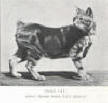
“Manx cats
may be considered shy breeders, and constantly the litter will consist of one
kitten only! I have been told that they are excellent mothers, but , in the
words of a Manx fancier, “they only care to have one family a year, many queens
won’t breed at all, and heaps of males are very funny and take no notice of
their wives!” Another breeder of Manx informs me that these cats seem entirely
fearless with dogs, and that her canines and felines live together in perfect
amity. I believe Mr. H.C. Brooke once exhibited a Manx in the same pen as a
bull dog at the South London Bull Dog Show of 1893.”
“Mr Brookes
was a well known and successful fancier of Manx wrote, “The silver tabby
“Champion and Premier Bonhaki” was breed by Mr. Jungbluth, one of the keepers of
the monkey house at the Zoo. He made his debut at the Botanic Gardens as a
kitten, when he was much admired by the then Princess of Wales, and Mr. Wain
awarded him the Championship. This success he followed up by winning four others
under various judges, and died at the early age of twenty seven months.
“Champion and Premier Katzenjammer” was bred at home. He did not commence his
show career till late, and then he had to meet “Bonhaki,” after whose death,
however, he was unbeaten, and had earned his Champion title at the time of his
death from gastritis last year, which robbed me of one of the most affectionate
pals man ever had, and I am not ashamed to own that many and bitter were the
tears I shed over his grave.”
The
Traditional Manx comes in all coat and eye colors except Lavender, Chocolate,
ticked, Pointed or these colors with white.
From the
beginning there were shorthaired and longhaired versions of the breed on the
Isle of Man and cats with both coat lengths were exported from the island. For a
while the government on the isle was keeping a government cattery for the
preservation of the longhaired and shorthaired types. Visitors to the cattery
could see both coat lengths in the country or origin. The longhaired version
became known as the Cymric, which is identical to the Traditional Manx in every
way except for their longer coat length.
TO TAIL OR NOT TO TAIL
One of the endearing qualities of the Traditional Manx is
its tail or absence of one. Their tail actually can come in a variety of
different lengths. Four types are described. The tailed have a full length
tail. A Stumpy has a short tail stump, which can usually be moved, though the
tail is often curved, knobby or kinked.. A rumpy-riser has one to three
vertebrae at the base of the spine that are usually immovable. Complete
taillessness is called a rumpy. The rumpy has no tail vertebrae at all and often
has a dimple at the base of the spine where the vertebrae would normally start.
For show purposes only the tailless Traditional Manx is considered favored.
Geneticists believe the tailless gene was a spontaneous mutation that occurred
within the cat population on the Isle of Man. The isolation of the Isle from a
broader population of cats improved the odds of the survival of this unique
gene. The dominant gene governing the lack of tail was easily passed to the
next generation.
Their lack of tail is controlled by a dominant gene, while
the tails of most other short tailed breeds are governed by recessive genes.
This suggests the Traditional Manx is not related to breeds such as the Japanese
Bobtail.
PERSONALITY
Loving and Loyal the Traditional Manx has devoted fans.
They can attach to only one person or only one family, who they feel comfortable
with. Still others happily greet everyone. Full of their own happy personality,
they create an endearing bond. Playful and fearless of heights, their powerful
hind legs propel them to high spots. They are excellent jumpers. They make
great household companions because they are intelligent, active and get along
with other pets (especially dogs). A good game of fetch is so enjoyable to
them. Known for their quiet voices, loud purrs and sweet temperaments, they can
be easily leash trained and are fascinated by water. Just don’t dip them in it!
They want to know what is going on, but don’t necessarily
want to be near all visitors. A joy to own they add endless pleasure and
entertainment.
In 1902 Frances Simpson wrote in her book, “The Book of the
Cat”, “From a personal knowledge of nearly all breeds, has no hesitation in
recommending the latter as companions, their quaint and doglike ways making them
general favourites whenever they are met with.”
What is their HEALTH ? ?
As a rule the Traditional Manx is a healthy breed with many
living to a ripe old age. Despite their lack of tail, they are perfectly capable
of landing on their feet and expressing their emotions just like any other cat.
The dominant gene governing the lack of tail or shorter
tail needs to be inherited from only one parent in order for the kitten to
manifest the trait. This means that if a kitten has one gene for taillessness
and another for a normal tail, taillessness will win out. In the case of the
Traditional Manx, however, the kitten cannot inherit the gene from more than one
parent. Homozygous kittens (kittens that inherit the Traditional Manx gene from
both parents) don’t develop past the embryo state due to malformations. On
average about 25% of the kittens in any given litter are homozygous, so litters
are small, with an average of two to four kittens. Scientific theory projects
any given litter from a Traditional Manx to Traditional Manx breeding will have
25% homozygous kittens, 25% normal tailed kittens and 50% heterozygous kittens
(kittens who inherit only one copy of the Traditional Manx gene) that will
manifest the Traditional Manx gene in some form.
Still the heterozygous kittens have a higher than average
mortality rate because the Traditional Manx gene can cause deformities such as
fusions of the spine, spina bifida, loss of control of the hind legs, weak hind
quarters, one weak leg, bowl and bladder abnormalities, and colon defects.
Because of these problems the Traditional Manx gene is called a lethal gene and
the set of problems that arise from the gene are called the Manx Syndrome. Roy
Robinson stated in his book “Genetics For Cat Breeders”, “It is unfortunate that
the Manx is associated with various anomalies of the lower vertebrae and anal
region. The various anomalies arise from the action of the M gene in causing
the taillessness and are inescapable in Manx breeding.”
Breeders state that careful breeding by using strong and
healthy cats minimized these defects. This is true in all breeds. There are
breeding challenges. All four tail types are included in breeding programs and
breeding rumpy to rumpy for more than 3 generations is avoided. This practice
helps reduce the likelihood of genetic problems.
A Traditional Manx can be expected to have the same life
span as any other cat. They are slow to mature, and reach their full growth and
weight around age 5. They are no more or less susceptible to feline diseases
than any other breed.
ONE SPECIAL KITTY
We don't always get the heart felt pictures and story that
you are about to see, but we know they are out there. Please enjoy these as they
were sent to us by a very caring owner.
" I wish you could have seen what a beautiful
and unusual cat she was. She seemed to smile even. :) She went everywhere
with us in the car. And hopped like a bunny when she ran.
|
Her one bad habit was stealing. She would jump up on a bureau and take
jewelry and hide it in her "special place" under Cylyn's bed. This was not popular when I boarded with a
large family prior to moving here. She even would even raid the bathroom when
someone was showering because their necklaces were usually available on the sink
shelf. But she won their hearts too! |
 |
This was my favorite cat, Thistle, that I lost from old age 8 years ago. She
was a Manx with a stub tail (pom pom) that I got from my husband's cousin and
was a real marshmallow kitty, a true companion, 1 in a million!! Below is my
new one.
|
Sitting on my husband's bureau top mirror. |
 |
| Her first winter here on our farm in 1981. |
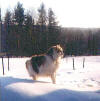 |
| And at 15 yrs old headed up to help with evening barn
chores. There is a rock in the background that looks like her nose is
huge. :) It was still little & cute. |
 |
| Thistle often played "house" with Cylyn. She was like a
doll and seemed to love the gentle attentions. |
 |
| Cylyn always tried to make her comfortable with doll
bedding |
 |
| And all good mamas dress them snuggly in their sweaters
when going out for a drive and put them safe in a car seat. |
 |
| But if it's too hot you don't wrap them in blankets when
they're put down for a nap. |
 |
| Life was good. |
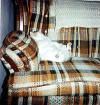 |
| .....except for all those camera flashes!! |
 |
| Coca Cola, Cokie, 4 weeks old, a Manx from my
husband's cousin farm. Not related to Thistle, but hopefully will be like
her. She will come home when Cylyn's does. |
 |
| |
|
TRADITIONAL COLORPOINT MANX
|
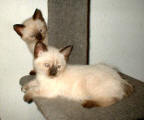 |
Click on Pix to Enlarge |
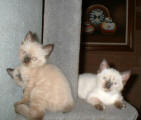 |
Here are two pictures of the Traditional
Colorpoint Manx.
|
|
|
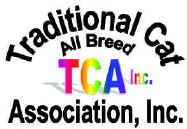
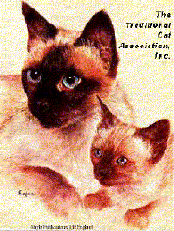 The
Traditional Cat Association,
Inc.©1987®TM
Official Website
The
Traditional Cat Association,
Inc.©1987®TM
Official Website
 Historically the Traditional Manx is an old breed, having
been around for at least several hundred years. Both shorthaired (Manx) and
longhaired (aka. Cymric) versions of the breed were present from the beginning.
Some have suggested that the longhaired Cymric was the result of a Manx to
Persian out cross occurring in the 1930’s and 1940’s. Others insist the Cymric
was not a human bred hybrid. Unlike the Manx gene, however, long hair is a
recessive trait, meaning the gene could have been carried unnoticed through
generations of Manx. The longhaired version was called the Cymric, derived from
Cymru, the Welsh or Celtic word for Wales. It is correctly pronounced (KOOM-rick)
but ordinarily pronounced (KIM-rick). The Cymric name was chosen by Blair
Wright and Leslie Falteisek. They were two Cymric breeders involved in the
recognition of the breed. It was Wright’s grandmother who said she saw
longhaired, tailless cats in Wales, thus inspiring the breeds Celtic moniker. To
maximize support and improve the breeds visibility, TCA, INC. has combined the
two using one breed name, but with two divisions.
Historically the Traditional Manx is an old breed, having
been around for at least several hundred years. Both shorthaired (Manx) and
longhaired (aka. Cymric) versions of the breed were present from the beginning.
Some have suggested that the longhaired Cymric was the result of a Manx to
Persian out cross occurring in the 1930’s and 1940’s. Others insist the Cymric
was not a human bred hybrid. Unlike the Manx gene, however, long hair is a
recessive trait, meaning the gene could have been carried unnoticed through
generations of Manx. The longhaired version was called the Cymric, derived from
Cymru, the Welsh or Celtic word for Wales. It is correctly pronounced (KOOM-rick)
but ordinarily pronounced (KIM-rick). The Cymric name was chosen by Blair
Wright and Leslie Falteisek. They were two Cymric breeders involved in the
recognition of the breed. It was Wright’s grandmother who said she saw
longhaired, tailless cats in Wales, thus inspiring the breeds Celtic moniker. To
maximize support and improve the breeds visibility, TCA, INC. has combined the
two using one breed name, but with two divisions. 
 for the introduction of the
Traditional Manx cat to the island. As the vessel drew close to the shore two
or three tail less cats leaped from the bowsprit and were taken by the wreckers.
These were the first of the kind ever seen in Man.”
for the introduction of the
Traditional Manx cat to the island. As the vessel drew close to the shore two
or three tail less cats leaped from the bowsprit and were taken by the wreckers.
These were the first of the kind ever seen in Man.”
 some way to the Traditional Manx.
These small cats he said “ had a graceful shape, yellow eyes and naturally
short tails.” During an invasion they were brought to Burma, and could have
traveled to the East Indies from Britain by English trading expeditions in the
18th century.
some way to the Traditional Manx.
These small cats he said “ had a graceful shape, yellow eyes and naturally
short tails.” During an invasion they were brought to Burma, and could have
traveled to the East Indies from Britain by English trading expeditions in the
18th century.
 From
“Our Cats and All About Them” by Harrison Weir, F.R.H.S., 1889, “The Manx cat is
well k known, and is by no means uncommon. It differs chiefly from the ordinary
domestic cat in being tailless, or nearly so, the best breeds not having any;
the hind legs are thicker and rather longer, particularly in the thighs. It runs
more like a hare than a cat the action of the legs being awkward, nor does it
seem to turn itself so readily, or with such rapidity and ease; the head is
somewhat small for its size, yet thick and well set on a rather long neck; the
eyes large, round, and full, ears medium, and rather rounded at the apex. In
colour they vary, but I do not remember to have seen a white or many black,
though one of the best that has come under my notice was the latter colour. I
have examined a number of specimens sent for exhibition at the Crystal palace
and other cat shows, and found in some a very short, thin, twisted tail, in
others a mere excrescence, and some with an appendage more like a knob. These I
have taken as having been operated upon when young, the tail being removed, but
this may not be the case, as Mr. St. George Mivart in his very valuable book on
the cat, mentions a case where a female cat has her tail so injured by the
passage of a cart wheel over it, that her master judged it best to have it cut
off near the base. Since then she has had two litters of kittens, and in each
litter one or more of the kittens had a stump of tail, while their brothers and
sisters had tails of the usual length. But were there no Manx cats in the neighbourhood, is a query. St. George Mivart further states that Mr. Bartlett
told him, as he has so stated to myself, that in the Isle of Man the cats have
tails of different lengths, from nothing up to ten inches. I cannot, myself,
come to the same conclusion as to the origin of the Manx cat. Be this as it
may, one thing is certain; that cross breed Manx with other cats often have
young that are tailless. As a proof of this, Mr. Herbert Young, of Harrogate,
has had in his possession a very find red female long-haired tailless cat, that
was bred between the Manx and a Persian. Another case showing the strong
prepotency of the Manx cat. Mr. Hodgkin, of Eridge, some time ago had a female
Manx cat sent to him.
From
“Our Cats and All About Them” by Harrison Weir, F.R.H.S., 1889, “The Manx cat is
well k known, and is by no means uncommon. It differs chiefly from the ordinary
domestic cat in being tailless, or nearly so, the best breeds not having any;
the hind legs are thicker and rather longer, particularly in the thighs. It runs
more like a hare than a cat the action of the legs being awkward, nor does it
seem to turn itself so readily, or with such rapidity and ease; the head is
somewhat small for its size, yet thick and well set on a rather long neck; the
eyes large, round, and full, ears medium, and rather rounded at the apex. In
colour they vary, but I do not remember to have seen a white or many black,
though one of the best that has come under my notice was the latter colour. I
have examined a number of specimens sent for exhibition at the Crystal palace
and other cat shows, and found in some a very short, thin, twisted tail, in
others a mere excrescence, and some with an appendage more like a knob. These I
have taken as having been operated upon when young, the tail being removed, but
this may not be the case, as Mr. St. George Mivart in his very valuable book on
the cat, mentions a case where a female cat has her tail so injured by the
passage of a cart wheel over it, that her master judged it best to have it cut
off near the base. Since then she has had two litters of kittens, and in each
litter one or more of the kittens had a stump of tail, while their brothers and
sisters had tails of the usual length. But were there no Manx cats in the neighbourhood, is a query. St. George Mivart further states that Mr. Bartlett
told him, as he has so stated to myself, that in the Isle of Man the cats have
tails of different lengths, from nothing up to ten inches. I cannot, myself,
come to the same conclusion as to the origin of the Manx cat. Be this as it
may, one thing is certain; that cross breed Manx with other cats often have
young that are tailless. As a proof of this, Mr. Herbert Young, of Harrogate,
has had in his possession a very find red female long-haired tailless cat, that
was bred between the Manx and a Persian. Another case showing the strong
prepotency of the Manx cat. Mr. Hodgkin, of Eridge, some time ago had a female
Manx cat sent to him. 
 “The illustration I give is that of a prize winner at the
Crystal palace in 1880,
“The illustration I give is that of a prize winner at the
Crystal palace in 1880,

 better be done, and when I was the little black
fellow I strongly recommended my friend to keep it and exhibit it at the next
large show, as I considered he would go in and win easily. She followed my
advice in the latter respect, but placed too low a figure on “Nig”, as she
declared she did not wish to go in for Manx. I warned her he would be sold, and
sure enough that clever and astute judge of cats of uncommon breeds, Mr. H.C.
Brooke, snapped him up at catalogue price; and since then he has blossomed forth
into a champion, and as “King Clinkie” has taken highest honours whenever
shown. It is only just to state that Mrs. Brooke most generously handed over
some of her winnings to “King Clinkies” former owner.
better be done, and when I was the little black
fellow I strongly recommended my friend to keep it and exhibit it at the next
large show, as I considered he would go in and win easily. She followed my
advice in the latter respect, but placed too low a figure on “Nig”, as she
declared she did not wish to go in for Manx. I warned her he would be sold, and
sure enough that clever and astute judge of cats of uncommon breeds, Mr. H.C.
Brooke, snapped him up at catalogue price; and since then he has blossomed forth
into a champion, and as “King Clinkie” has taken highest honours whenever
shown. It is only just to state that Mrs. Brooke most generously handed over
some of her winnings to “King Clinkies” former owner.



 “The following letters which appeared in Our Cats, in the
issue of June 30th, 1900, will be read with interest. They were
written by two gentlemen of prominent position in the Isle of Man, but as they
did not wish to be identified as authorities on cats their names were not
given…”
“The following letters which appeared in Our Cats, in the
issue of June 30th, 1900, will be read with interest. They were
written by two gentlemen of prominent position in the Isle of Man, but as they
did not wish to be identified as authorities on cats their names were not
given…”
















